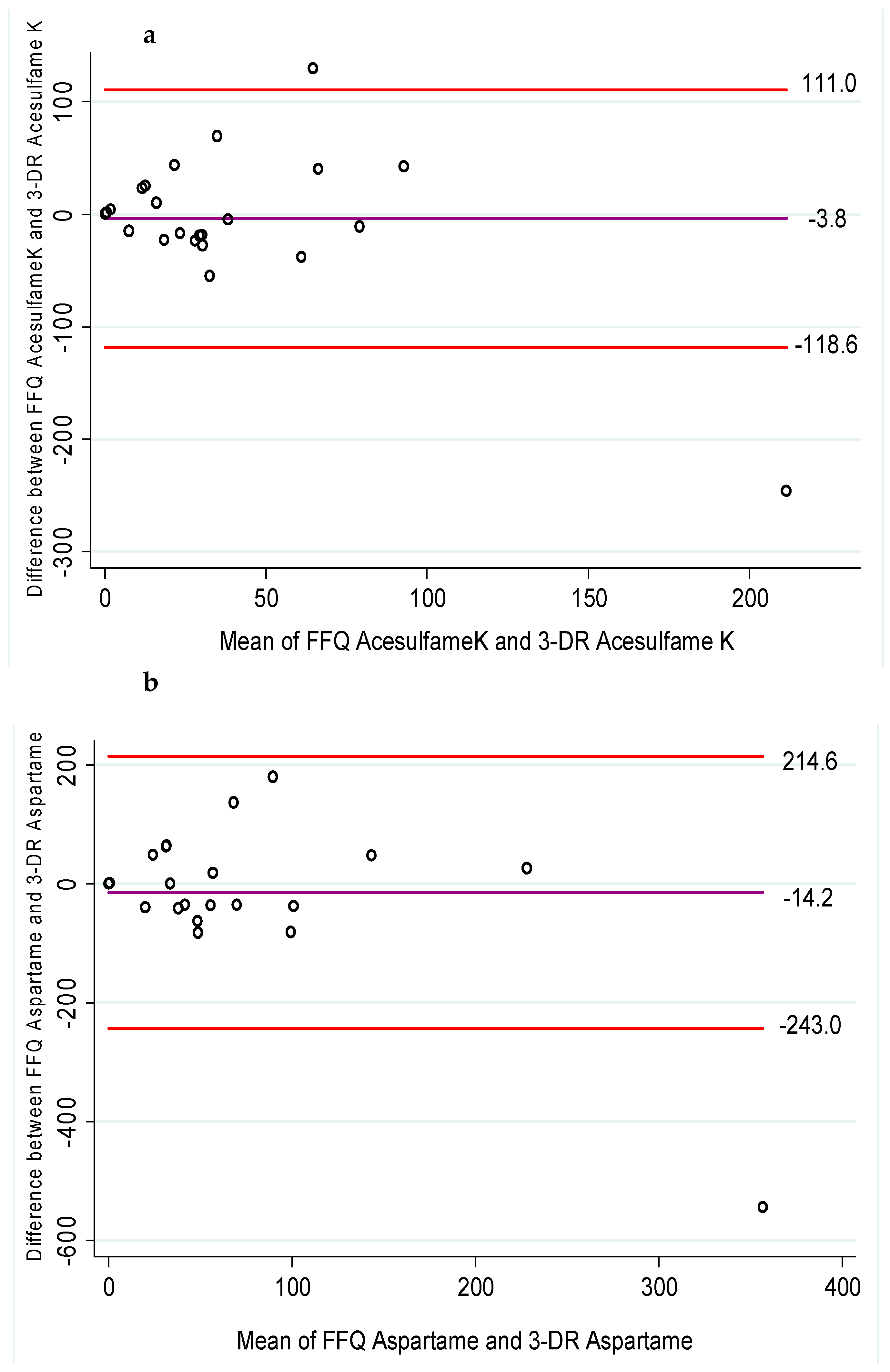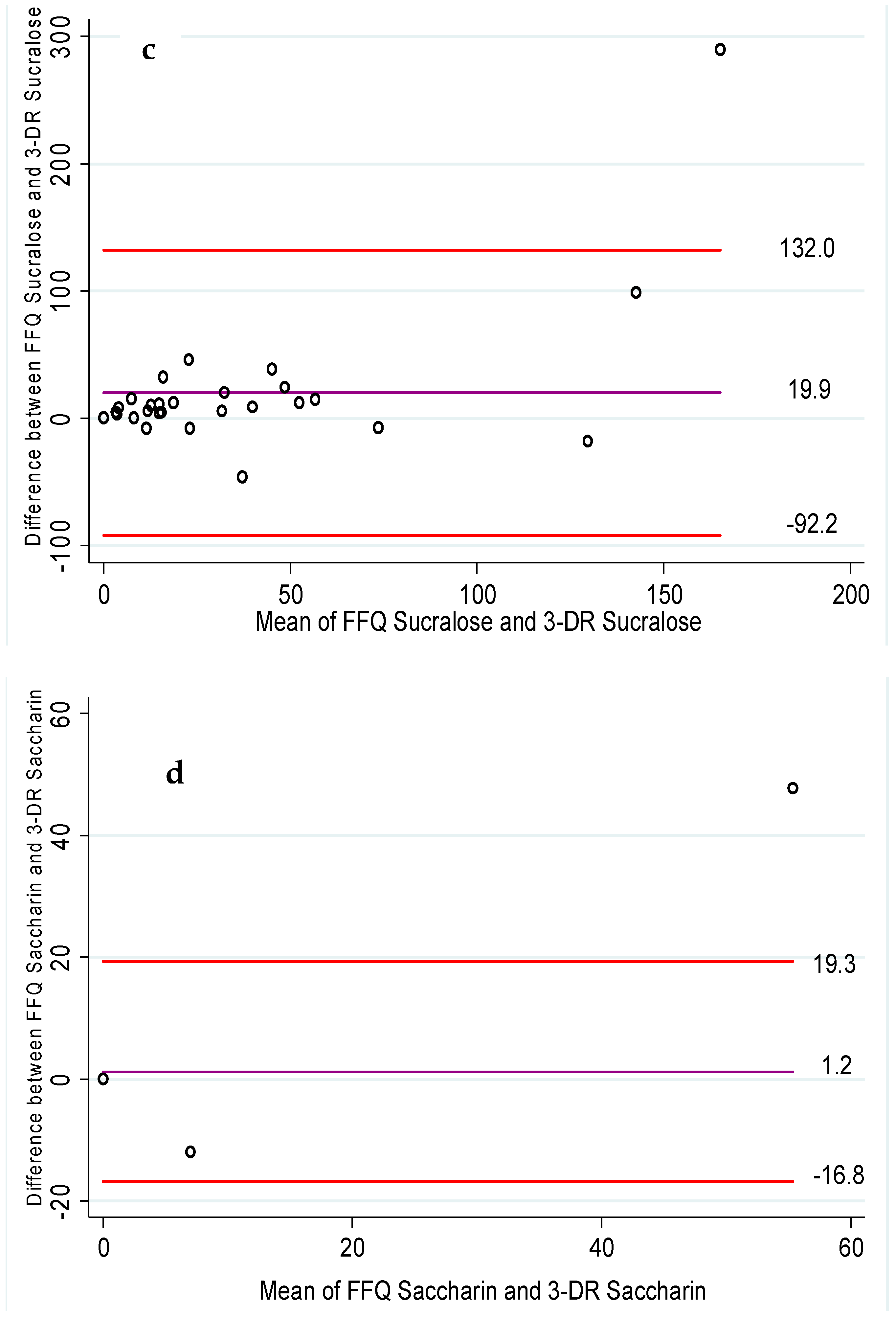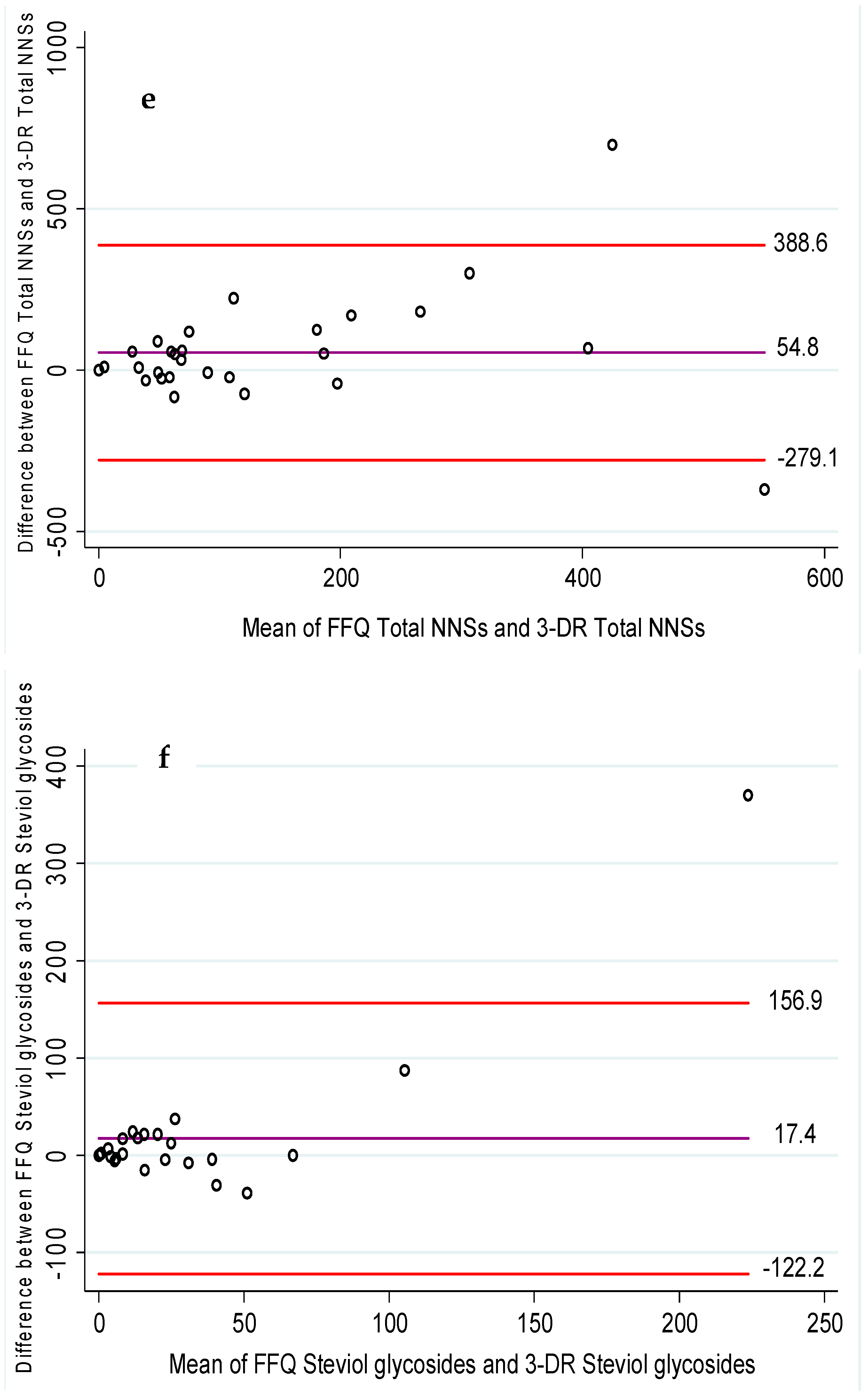Development and Relative Validation of a Food Frequency Questionnaire to Assess Non-Nutritive Sweeteners Intake among Pregnant Women in Santiago, Chile: A Pilot Study
Abstract
1. Introduction
2. Material and Methods
2.1. Study Design
2.2. Food Frequency Questionnaire
2.3. Three-Day Dietary Records
2.4. Statistical Analyses
3. Results
3.1. Descriptive Statistics
3.2. Correlations
3.3. Agreement between Methods
4. Discussion
5. Conclusions
Author Contributions
Funding
Institutional Review Board Statement
Informed Consent Statement
Data Availability Statement
Conflicts of Interest
References
- Serra-Majem, L.; Raposo, A.; Aranceta-Bartrina, J.; Varela-Moreiras, G.; Logue, C.; Laviada, H.; Socolovsky, S.; Pérez-Rodrigo, C.; Aldrete-Velasco, J.A.; Meneses Sierra, E.; et al. Ibero–American consensus on low-and no-calorie sweeteners: Safety, nutritional aspects and benefits in food and beverages. Nutrients 2018, 10, 818. [Google Scholar] [CrossRef] [PubMed]
- Bailón Uriza, R.; Ayala Méndez, J.A.; Cavagnari, B.M.; Celis González, C.; Chapa Tellez, R.; Chávez Brambila, J.; Espinosa-Marrón, A.; Plascencia, J.L.; Alarcón, M.G.L.; García, R.L.; et al. Edulcorantes no calóricos en la mujer en edad reproductiva: Documento de consenso. Nutr. Hosp. 2020, 37, 211–222. [Google Scholar] [PubMed]
- Ayoob, K.T. Consumption of non-nutritive sweeteners during pregnancy. Am. J. Obstet. Gynecol. 2020, 223, 952–953. [Google Scholar] [CrossRef]
- Sylvetsky, A.; Rother, K.I.; Brown, R. Artificial sweetener use among children: Epidemiology, recommendations, metabolic outcomes, and future directions. Pediatr. Clin. N. Am. 2011, 58, 1467. [Google Scholar] [CrossRef] [PubMed]
- Sylvetsky, A.C.; Blau, J.E.; Rother, K.I. Understanding the metabolic and health effects of low-calorie sweeteners: Methodological considerations and implications for future research. Rev. Endocr. Metab. Disord. 2016, 17, 187–194. [Google Scholar] [CrossRef]
- Corvalán, C.; Reyes, M.; Garmendia, M.L.; Uauy, R. Structural responses to the obesity and non-communicable diseases epidemic: Update on the Chilean law of food labelling and advertising. Obes. Rev. 2019, 20, 367–374. [Google Scholar]
- Kanter, R.; Reyes, M.; Vandevijvere, S.; Swinburn, B.; Corvalán, C. Anticipatory effects of the implementation of the Chilean Law of Food Labeling and Advertising on food and beverage product reformulation. Obes. Rev. 2019, 20, 129–140. [Google Scholar] [PubMed]
- Quitral, V.; Arteaga, J.; Rivera, M.; Galleguillos, J.; Valdés, I. Comparación del contenido de azúcares y edulcorantes no calóricos en néctares y bebidas antes y después de implementar la ley chilena 20.606. Rev. Chil. Nutr. 2019, 46, 245–253. [Google Scholar]
- Sambra, V.; López-Arana, S.; Cáceres, P.; Abrigo, K.; Collinao, J.; Espinoza, A.; Gotteland, M. Overuse of non-caloric sweeteners in foods and beverages in Chile: A threat to consumers’ free choice? Front. Nutr. 2020, 7, 68. [Google Scholar] [CrossRef]
- Gallus, S.; Scotti, L.; Negri, E.; Talamini, R.; Franceschi, S.; Montella, M.; Giacosa, A.; Maso, L.D.; La Vecchia, C. Artificial sweeteners and cancer risk in a network of case–control studies. Ann. Oncol. 2007, 18, 40–44. [Google Scholar] [CrossRef]
- Lohner, S.; Toews, I.; Meerpohl, J.J. Health outcomes of non-nutritive sweeteners: Analysis of the research landscape. Nutr. J. 2017, 16, 55. [Google Scholar] [CrossRef] [PubMed]
- Lohner, S.; de Gaudry, D.K.; Toews, I.; Ferenci, T.; Meerpohl, J.J. Non-nutritive sweeteners for diabetes mellitus. Cochrane Database Syst. Rev. 2020, 5, CD012885. [Google Scholar] [CrossRef]
- Liauchonak, I.; Qorri, B.; Dawoud, F.; Riat, Y.; Szewczuk, M.R. Non-Nutritive sweeteners and their implications on the development of metabolic syndrome. Nutrients 2019, 11, 644. [Google Scholar] [CrossRef] [PubMed]
- Pase, M.P.; Seshadri, S.; Jacques, P.F.; Klein, R.B.; Fenton, T.; Bellman, J.; Wersching, H.; Gardener, H.; Sacco, R.L.; Himali, J.J.; et al. Sugar- and artificially sweetened beverages and the risks of incident stroke and dementia: A prospective cohort study. Stroke 2017, 48, 1139–1146. [Google Scholar] [CrossRef] [PubMed]
- Use of Non-Sugar Sweeteners: WHO Guideline; World Health Organization: Geneva, Switzerland, 2023.
- Plows, J.F.; Morton-Jones, J.; Bridge-Comer, P.E.; Ponnampalam, A.; Stanley, J.L.; Vickers, M.H.; Reynolds, C.M. Consumption of the Artificial Sweetener Acesulfame Potassium throughout Pregnancy Induces Glucose Intolerance and Adipose Tissue Dysfunction in Mice. J. Nutr. 2020, 150, 1773–1781. [Google Scholar] [CrossRef] [PubMed]
- Maslova, E.; Strøm, M.; Olsen, S.F.; Halldórsson, T.I. Consumption of artificially-sweetened soft drinks in pregnancy and risk of child asthma and allergic rhinitis. PLoS ONE 2013, 8, e57261. [Google Scholar] [CrossRef]
- Cai, C.; Sivak, A. Davenport MH. Effects of prenatal artificial sweeteners consumption on birth outcomes: A systematic review and meta-analysis. Public Health Nutr. 2021, 24, 5024–5033. [Google Scholar] [CrossRef]
- Azad, M.B.; Sharma, A.K.; de Souza, R.J.; Dolinsky, V.W.; Becker, A.B.; Mandhane, P.J.; Turvey, S.E.; Subbarao, P.; Lefebvre, D.L.; Sears, M.R.; et al. Canadian Healthy Infant Longitudinal Development Study Investigators. Association between artificially sweetened beverage consumption during pregnancy and infant body mass index. JAMA Pediatr. 2016, 170, 662–670. [Google Scholar] [CrossRef]
- Myers, E.A.; Passaro, E.M.; Hedrick, V.E. The reproducibility and comparative validity of a non-nutritive sweetener food frequency questionnaire. Nutrients 2018, 10, 334. [Google Scholar] [CrossRef]
- Willett, W. Nutritional Epidemiology; Oxford University Press: Oxford, UK, 2012. [Google Scholar]
- Gibson, R.S. Principles of Nutritional Assessment; Oxford University Press: New York, NY, USA, 2005. [Google Scholar]
- Rodrigo, C.P.; Aranceta, J.; Salvador, G.; Varela-Moreiras, G. Food frequency questionnaires. Nutr. Hosp. 2015, 31, 49–56. [Google Scholar]
- Cade, J.; Thompson, R.; Burley, V.; Warm, D. Development, validation and utilisation of food-frequency questionnaires–A review. Public Health Nutr. 2002, 5, 567–587. [Google Scholar] [CrossRef] [PubMed]
- Mertens, E.; Kuijsten, A.; Geleijnse, J.M.; Boshuizen, H.C.; Feskens, E.J.; van’t Veer, P. FFQ versus repeated 24-h recalls for estimating diet-related environmental impact. Nutr. J. 2019, 18, 2. [Google Scholar] [CrossRef] [PubMed]
- Kanter, R.; Vanderlee, L.; Vandevijvere, S. Front-of-package nutrition labelling policy: Global progress and future directions. Public Health Nutr. 2018, 21, 1399–1408. [Google Scholar] [CrossRef]
- Tylavsky, F.A.; Sharp, G.B. Misclassification of nutrient and energy intake from use of closed-ended questions in epidemiologic research. Am. J. Epidemiol. 1995, 142, 342–352. [Google Scholar] [CrossRef] [PubMed]
- Cerda, R.; Barrera, C.; Arena, M.; Bascuñán, K.A.; Jimenez, G. Photographic Atlas of Chilean Food and Typical Preparations. Natl. Surv. Food Consum. 2010. Available online: http://www.repositoriodigital.minsal.cl/handle/2015/902?show=full (accessed on 24 May 2023).
- Lawrence, I.; Lin, K. A concordance correlation coefficient to evaluate reproducibility. Biometrics 1989, 45, 255–268. [Google Scholar]
- Chen, C.-C.; Barnhart, H.X. Assessing agreement with intraclass correlation coefficient and concordance correlation coefficient for data with repeated measures. Comput. Stat. Data Anal. 2013, 60, 132–145. [Google Scholar] [CrossRef]
- Hernaez, R. Reliability and agreement studies: A guide for clinical investigators. Gut 2015, 64, 1018–1027. [Google Scholar] [CrossRef]
- Lu, M.-J.; Zhong, W.-H.; Liu, Y.-X.; Miao, H.-Z.; Li, Y.-C.; Ji, M.-H. Sample size for assessing agreement between two methods of measurement by Bland−Altman method. Int. J. Biostat. 2016, 12. [Google Scholar] [CrossRef]
- Bland, J.M.; Altman, D. Statistical methods for assessing agreement between two methods of clinical measurement. Lancet 1986, 327, 307–310. [Google Scholar] [CrossRef]
- Aggarwal, R.; Ranganathan, P. Common pitfalls in statistical analysis: The use of correlation techniques. Perspect. Clin. Res. 2016, 7, 187. [Google Scholar]
- Ministerio de Salud. Reglamento Sanitario de Los Alimentos. Articulo 146. 2020. Available online: https://www.minsal.cl/sites/default/files/files/DECRETO_977_96%20actualizado%20a%20Enero%202015(1).pdf (accessed on 24 May 2023).
- Vera, C.; Illanes, A. Lactose-derived nondigestible oligosaccharides and other high added-value products. In Lact. Prebiotics—A Process Prospect, 1st ed.; Illanes, A., Guerr, C., Vera, C., Wilson, L., Conejeros, R., Scott, F., Eds.; 2016; pp. 87–110. ISBN 9780128027455. [Google Scholar] [CrossRef]
- FAO Dietary Assessment. A Resource Guide to Method Selection and Application in Low Resource Settings; FAO: Rome, Italy, 2018. [Google Scholar]
- Koo, T.K.; Li, M.Y. A guideline of selecting and reporting intraclass correlation coefficients for reliability research. J. Chiropr. Med. 2016, 15, 155–163. [Google Scholar] [CrossRef] [PubMed]
- Steichen, T.J.; Cox, N.J. A note on the concordance correlation coefficient. Stata J. 2002, 2, 183–189. [Google Scholar] [CrossRef]
- Durán, S.; Quijada, M.; Silva, L.; Almonacid, N.; Berlanga, M.; Rodríguez, M. Niveles de ingesta diaria de edulcorantes no nutritivos en escolares de la región de Valparaíso. Rev. Chil. Nutr. 2011, 38, 444–449. [Google Scholar] [CrossRef]
- Hamilton, V.; Guzmán, E.; Golusda, C.; Lera, L.; Cornejo, V. Edulcorantes no nutritivos e ingesta diaria admisible en adultos y niños de peso normal y obesos de tres niveles socioeconómicos, y un grupo de diabéticos de la Región Metropolitana. Rev. Chil. Nutr. 2013, 40, 123–128. [Google Scholar] [CrossRef]
- Martínez, X.; Zapata, Y.; Pinto, V.; Cornejo, C.; Elbers, M.; van der Graaf, M.; Villarroel, L.; Hodgson, M.I.; Rigotti, A.; Echeverría, G. Intake of Non-Nutritive Sweeteners in Chilean Children after Enforcement of a New Food Labeling Law that Regulates Added Sugar Content in Processed Foods. Nutrients 2020, 12, 1594. [Google Scholar] [CrossRef]
- Venturi, G.; Di Luca, M.; Fortuna, C.; Remoli, M.E.; Riccardo, F.; Severini, F.; Toma, L.; Del Manso, M.; Benedetti, E.; Caporali, M.G.; et al. Consumption of non-nutritive sweeteners by pre-schoolers of the food and environment Chilean cohort (FECHIC) before the implementation of the Chilean food labelling and advertising law. Nutr. J. 2020, 19, 69. [Google Scholar]
- Durán Agüero, S.; Vásquez Leiva, A.; Morales Illanes, G.; Schifferli Castro, I.; Sanhueza Espinoza, C.; Encina Vega, C.; Cuevas, K.V.; Mena Bolvaran, F. Consumo de stevia en estudiantes universitarios chilenos y su asociación con el estado nutricional. Nutr. Hosp. 2015, 32, 362–366. [Google Scholar]
- Durán Agüero, S.; Record Cornwall, J.; Encina Vega, C.; Salazar de Ariza, J.; Cordón Arrivillaga, K.; Cereceda Bujaico, M.D.P.; Alzamora, S.A.; Espinoza Bernardo, S. Consumo de edulcorantes no nutritivos en bebidas carbonatadas en estudiantes universitarios de algunos países de Latinoamérica. Nutr. Hosp. 2015, 31, 959–965. [Google Scholar]
- Fuentealba Arevalo, F.; Espinoza Espinoza, J.; Salazar Ibacache, C.; Duran Aguero, S. Consumption of non-caloric sweeteners among pregnant Chileans: A cross-sectional study. Nutr. Hosp. 2019, 36, 890–897. [Google Scholar]
- Berglund, L. Regression dilution bias: Tools for correction methods and sample size calculation. Ups. J. Med. Sci. 2012, 117, 279–283. [Google Scholar] [CrossRef]
- Bautista, L.E.; Herran, O.F.; Pryer, J.A. Development and simulated validation of a food-frequency questionnaire for the Colombian population. Public Health Nutr. 2005, 8, 181–188. [Google Scholar] [CrossRef] [PubMed]
- Aldunate, R.; Contreras, G.; De la Huerta, C.; Tapia, M. Characterization of the Recent Immigration to Chile; Central Bank of Chile: Santiago, Chile, 2019. [Google Scholar]
- Ogawa, K.; Jwa, S.C.; Kobayashi, M.; Morisaki, N.; Sago, H.; Fujiwara, T. Validation of a food frequency questionnaire for Japanese pregnant women with and without nausea and vomiting in early pregnancy. J. Epidemiol. 2017, 27, 201–208. [Google Scholar] [CrossRef] [PubMed]
- Departamento de Extranjería y Migración. Estadísticas Migratorias. 2019. Available online: https://www.migracionenchile.cl/wp-content/uploads/2020/06/MIGRACION-EN-CHILE-V7.pdf (accessed on 24 May 2023).




| Characteristics | 25th–75th Percentile or % |
|---|---|
| Age (years), median (IQR) 1 | 31.2 (26.9–34.7) |
| Gestational weeks, median (IQR) 1 | 30.0 (28.0–32.0) |
| Parity n (%) | |
| 0 | 20 (69.0) |
| ≥1 | 9 (31.0) |
| Pre-gestational weight, median (IQR) 1 | 60.0 (55.0–66.0) |
| Current weight, median (IQR) 1 | 68.0 (63.0–73.0) |
| Medical history n (%) | |
| Gestational diabetes | 3 (10.3) |
| Hypothyroidism | 3 (10.3) |
| High blood pressure | 1 (3.4) |
| Nationality n (%) | |
| Chilean | 20 (69.0) |
| Other | 9 (31.0) |
| Education n (%) | |
| High school | 7 (24.1) |
| Vocational training | 3 (10.4) |
| College or more | 19 (65.5) |
| Employment n (%) | |
| Yes | 23 (79.3) |
| No | 6 (20.7) |
| Diet | |
| Total energy intake (kcal/d). Mean ± SD 2 | 1873 ± 416 |
| Protein intake (g/d). Mean ± SD 2 | 75.5 ± 26.3 |
| Carbohydrate intake (g/d). Mean ± SD 2 | 245.3 ± 64.0 |
| Fat intake (g/d). Mean ± SD 2 | 70.0 ± 7.5 |
| NNS Type | n a | FFQ on Daily NNS Intake (mg/day) | FFQ on Daily NNS Intake (mg/kg bw) | n a | 3-DR of Daily NNS Intake (mg/day) | 3-DR of Daily NNS Intake (mg/kg bw) | ADI Defined by EFSA (mg/kg bw) |
|---|---|---|---|---|---|---|---|
| Median (25th–75th Percentile) | Median (25th–75th Percentile) | Median (25th–75th Percentile) | Median (25th–75th Percentile) | ||||
| Acesulfame K | 23 | 20.9 (7.0–69.7) | 0.38 (0.11–1.00) | 15 | 40.5 (32.0–71.6) | 0.65 (0.45–1.16) | 9 |
| Aspartame | 19 | 59.1 (24.0–84.6) | 0.38 (0.02–0.86) | 14 | 84.0 (58.5–120.0) | 0.40 (0.01–0.93) | 40 |
| Cyclamate | 1 | 3.1 b | 0.06 b | 1 | 38.5 b | 0.71 b | 7 |
| Saccharin | 3 | 1.1 (0.01–79.2) | 0.02 (0.00–1.28) | 2 | 22.3 (13.0–31.5) | 0.37 (0.24–0.51) | 5 |
| Sucralose | 27 | 24.8 (14.6–60.6) | 0.38 (0.20–0.94) | 23 | 22.4 (9.4–46.5) | 0.33 (0.17–0.75) | 15 |
| Steviol glycosides | 25 | 22.0 (4.2–31.2) | 0.31 (0.06–0.49) | 18 | 21.6 (7.8–41.3) | 0.31 (0.12–0.62) | 4 |
| D-Tagatose | 1 | 3.5 b | 0.05 b | 1 | 2.7 | 0.04 b | not specified |
| Total NNS intake | 27 | 93.0 (47.6–242.7) | 1.49 (0.73–3.37) | 24 | 68.0 (36.7–104.8) | 1.28 (0.62–2.48) | not specified |
| NNS Type | Rho Coefficients between FFQ and 3-DR | CCC between FFQ and 3-DR (95% CI) |
|---|---|---|
| Acesulfame K | 0.50 * | 0.37 (0.07–0.61) * |
| Aspartame | 0.51 * | 0.28 (−0.01–0.52) |
| Cyclamate | n/a *** | n/a *** |
| Saccharin | 0.83 ** | 0.66 (0.58–0.74) ** |
| Sucralose | 0.67 ** | 0.35 (0.09–0.56) ** |
| Steviol glycosides | 0.79 * | 0.22 (0.04–0.38) |
| D-Tagatose | n/a *** | n/a *** |
| Total NNS intake | 0.66 ** | 0.39 (0.02–0.66) * |
Disclaimer/Publisher’s Note: The statements, opinions and data contained in all publications are solely those of the individual author(s) and contributor(s) and not of MDPI and/or the editor(s). MDPI and/or the editor(s) disclaim responsibility for any injury to people or property resulting from any ideas, methods, instructions or products referred to in the content. |
© 2023 by the authors. Licensee MDPI, Basel, Switzerland. This article is an open access article distributed under the terms and conditions of the Creative Commons Attribution (CC BY) license (https://creativecommons.org/licenses/by/4.0/).
Share and Cite
López-Arana, S.; Peralta, R.; Sambra, V.; Abrigo, K.; Prado, G.; Cáceres, P.; Carvajal, B.; Gotteland, M. Development and Relative Validation of a Food Frequency Questionnaire to Assess Non-Nutritive Sweeteners Intake among Pregnant Women in Santiago, Chile: A Pilot Study. Nutrients 2023, 15, 2518. https://doi.org/10.3390/nu15112518
López-Arana S, Peralta R, Sambra V, Abrigo K, Prado G, Cáceres P, Carvajal B, Gotteland M. Development and Relative Validation of a Food Frequency Questionnaire to Assess Non-Nutritive Sweeteners Intake among Pregnant Women in Santiago, Chile: A Pilot Study. Nutrients. 2023; 15(11):2518. https://doi.org/10.3390/nu15112518
Chicago/Turabian StyleLópez-Arana, Sandra, Rebeca Peralta, Verónica Sambra, Karen Abrigo, Gabriel Prado, Paola Cáceres, Bielka Carvajal, and Martin Gotteland. 2023. "Development and Relative Validation of a Food Frequency Questionnaire to Assess Non-Nutritive Sweeteners Intake among Pregnant Women in Santiago, Chile: A Pilot Study" Nutrients 15, no. 11: 2518. https://doi.org/10.3390/nu15112518
APA StyleLópez-Arana, S., Peralta, R., Sambra, V., Abrigo, K., Prado, G., Cáceres, P., Carvajal, B., & Gotteland, M. (2023). Development and Relative Validation of a Food Frequency Questionnaire to Assess Non-Nutritive Sweeteners Intake among Pregnant Women in Santiago, Chile: A Pilot Study. Nutrients, 15(11), 2518. https://doi.org/10.3390/nu15112518






